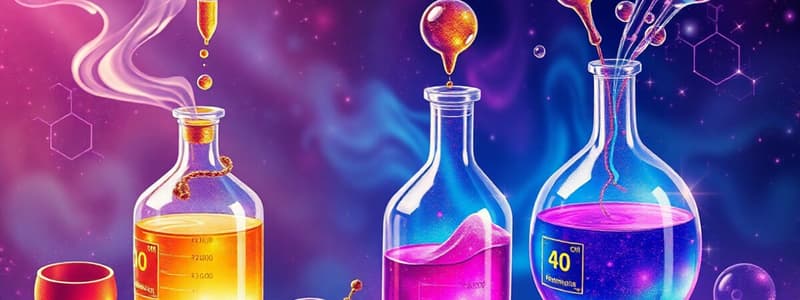Podcast
Questions and Answers
What is the primary function of RMgX when reacting with R-C-H to form R-C-OH?
What is the primary function of RMgX when reacting with R-C-H to form R-C-OH?
- It provides steric hindrance.
- It serves as a nucleophile. (correct)
- It acts as a dehydrating agent.
- It promotes elimination reactions.
In an $S_N2$ reaction, which factor is critical for the nucleophile to effectively replace the leaving group?
In an $S_N2$ reaction, which factor is critical for the nucleophile to effectively replace the leaving group?
- The nucleophile must be stronger than the leaving group. (correct)
- The nucleophile must be more electronegative than the leaving group.
- The leaving group must be a strong acid.
- The nucleophile must be bulky to stabilize the transition state.
What is the outcome when RMgX is used in the reaction with R-C-H and H2SO4?
What is the outcome when RMgX is used in the reaction with R-C-H and H2SO4?
- R-C-H is converted to R-S-OH. (correct)
- R-C-H is converted to R-C-OH.
- R-C-H is converted to R-C-R.
- R-C-H remains unchanged.
Which of the following statements accurately describes the requirements for a successful $S_N2$ substitution?
Which of the following statements accurately describes the requirements for a successful $S_N2$ substitution?
When RMgX reacts with R-C-H in the presence of water, which of the following products is formed?
When RMgX reacts with R-C-H in the presence of water, which of the following products is formed?
Flashcards
SN2 Reaction
SN2 Reaction
A chemical reaction where a nucleophile (Nu) attacks an electrophilic carbon atom bonded to a leaving group (LG), resulting in the substitution of the leaving group with the nucleophile. This reaction occurs in one step and proceeds through a transition state, where the nucleophile and the leaving group are both partially bonded to the carbon.
Nucleophile Strength in SN2
Nucleophile Strength in SN2
The nucleophile (Nu) must be stronger than the leaving group (LG) for the reaction to occur. This means the nucleophile must be more stable in its environment.
Ring Strain
Ring Strain
A type of reaction where a molecule undergoes an internal rearrangement. This involves the breaking and forming of bonds within the molecule. This often occurs in molecules with cyclic structures.
SN1 Reaction
SN1 Reaction
Signup and view all the flashcards
Carbocation Stability in SN1
Carbocation Stability in SN1
Signup and view all the flashcards




